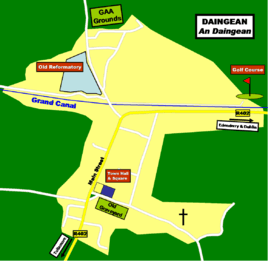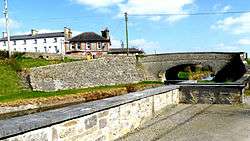Daingean
| Daingean an Daingean | |
|---|---|
| Town | |
|
Molesworth Bridge, Daingean as seen from the Harbour | |
 Daingean Location in Ireland | |
| Coordinates: 53°17′42″N 7°17′31″W / 53.295°N 7.292°WCoordinates: 53°17′42″N 7°17′31″W / 53.295°N 7.292°W | |
| Country | Ireland |
| Province | Leinster |
| County | Offaly |
| Government | |
| • Dáil Éireann | Laois-Offaly |
| Elevation | 78 m (256 ft) |
| Population (2011)[1] | |
| • Urban | 1,037 |
| • Rural | 391 |
| Time zone | WET (UTC+0) |
| • Summer (DST) | IST (WEST) (UTC-1) |
| Area code(s) | 057 |
| Irish Grid Reference | N474275 |
| Website | |
| Historical population | ||
|---|---|---|
| Year | Pop. | ±% |
| 1821 | 1,619 | — |
| 1831 | 1,454 | −10.2% |
| 1841 | 1,189 | −18.2% |
| 1851 | 748 | −37.1% |
| 1861 | 1,074 | +43.6% |
| 1871 | 820 | −23.6% |
| 1881 | 829 | +1.1% |
| 1891 | 836 | +0.8% |
| 1901 | 778 | −6.9% |
| 1911 | 659 | −15.3% |
| 1926 | 460 | −30.2% |
| 1936 | 518 | +12.6% |
| 1946 | 663 | +28.0% |
| 1951 | 660 | −0.5% |
| 1956 | 648 | −1.8% |
| 1961 | 679 | +4.8% |
| 1966 | 605 | −10.9% |
| 1971 | 492 | −18.7% |
| 1981 | 551 | +12.0% |
| 1986 | 659 | +19.6% |
| 1991 | 641 | −2.7% |
| 1996 | 679 | +5.9% |
| 2002 | 777 | +14.4% |
| 2006 | 1,056 | +35.9% |
| 2011 | 1,037 | −1.8% |
| [2][3][4][5][6] | ||
Daingean (/ˈdæŋɡən/; Irish: An Daingean, meaning "the fort" or Daingean Ua bhFáilghe), formerly Philipstown, is a small town in east County Offaly, Ireland. It is situated midway between the towns of Tullamore and Edenderry on the R402 regional road. The town or townland of Daingean has a population (2002) of 777 [7] while the District Electoral Division (DED) has a total population of 1168.[7] It is the principal town of the Daingean Catholic Parish.[8] The other main poles of this parish are Ballycommon, Kilclonfert and Cappincur.
History
Daingean was originally named Philipstown in 1556 when it was established as the county town in the land that was planted by Queen Mary I in the newly shired King’s County. The town and the county was so named after her husband and co-monarch, King Philip.
The town was once the seat of the O’Connor clan, who were chieftains of the surrounding area of Offaly. Its current name ‘Daingean’ from Daingean Ua bhFáilghe means fortress of the Uí Fáilghe clan, a name that it derived from the medieval island fortress of O'Connor Faly. In 1883 Tullamore replaced Daingean as the focal point of the county. As a result, Philipstown was demoted from capital town to village and as a result lost most of its political status. It was in 1922, with the foundation of the Free State, that the village was renamed Daingean, at the same time as County Offaly replaced the old King's County.
In the 1850s the jail (then known as Philipstown gaol) was used to detain people who were convicted and sentenced to transportation to Australia while they waited for a ship to transport them. Many of them died in the jail after spending several years waiting to be transported.[9]
Daingean has long boasted a strong status as a Midlands town and this was never more evident than at the start of the 20th century when Daingean displayed at various points a number of important public buildings including the courthouse, the design of which is locally attributed to James Gandon, designer of the Four Courts in Dublin. In addition there is a children's reformatory (mentioned in the Ryan Report), remnants of a military barracks (known as the footbarrack) giving its name to the bridge leading out of the town towards Tullamore - the footbarrack bridge. There are the remnants of an Anglican church and a functioning Roman Catholic church. Of these buildings all can still be seen in various states but few are still used for their original functions within the village. The courthouse has functioned as a town hall, dance hall and bingo palace having been renovated in the 1980s by the state training body AnCO, using local labour.

A bog body, given the name Old Croghan Man, was found near Daingean in 2004 and featured on the BBC Two Timewatch programme in January 2006.
A book called From the Quiet Annals of Daingean was written and published by John Kearney, Main St., Daingean, Co. Offaly in December 2006.[10]
While there is a local farming economy, many of the people from Daingean work in Tullamore or as far afield as Dublin or Athlone while commuting daily. Daingean is surrounded by the Bog of Allen and Bord Na Mona (BnM) remains a key employer, however the number employed is much reduced from the heyday when local people made a good living working at the Briquette Factory and on the bog including significant numbers of seasonal workers. The ESB power station at nearby Rhode was also a significant employer before its closure. Even in the period of very high unemployment in the 1980s the ESB and BnM trained local men in their apprenticeship programmes.
Publican Matt Farrell was murdered in this town on 1 April 2009.[11] A €10,000 reward was offered for information when the crime had not been solved several months later.[12]
Tourist attractions
The Grand Canal, which links Dublin and the River Shannon, passes through the village. The village has its own 18-hole golf course, Castle Barna Golf Club. Daingean is home to Grand Canal Adventures who provide kayaking, water zorbing, bicycle hire and other water sports and leisure activities on the canal.
Cultural events
The Daingean Homecoming Festival is a week-long event hosted at the beginning of each August.[13] One of the most anticipated events at the festival is a raft race on the Grand Canal other events include the parade, traditional threshing, karaoke competition and children's day in recent years the canal gladiators competition was introduced. During the Daingean Homecoming Festival a Festival Queen is selected by a panel of judges.[14] The festival Queen selection is made in a similar style to the Rose of Tralee. On the Friday night of the Homecoming Festival Tullamore Harriers Athletic Club organise the annual Daingean 5 km Road Race. This race makes four loops of the town on a circuit including Main Street, Church Street, Canal View, and Circular Road. A set of Flickr photographs[15] are available for the 2011 race. The race is usually well attended with over 100 runners taking part adding colour and excitement to the town.
Transport
The regional R402 road forms the principal street of Daingean known as Main Street. This road links Enfield, Edenderry, Daingean, Ballinagar and (through the R420) Tullamore.
Daingean is served by a Bus Éireann commuter bus service through Route 120.
The nearest railway station is Tullamore railway station, approximately 17.5 km (10.9 mi) or 15 to 20 minutes away.

People from Daingean
- Patrick Dunne (1818–1900), a Roman Catholic priest who ministered in Australia, was born in Philipstown.
- Lord Charles Beresford (1846-1919), British admiral and politician; son of the 4th Marquess of Waterton, born in Philipstown.
- Joe Connor (1877-1934), an Irish international footballer who played for West Bromwich Albion, Arsenal and Fulham among others, was born in Philipstown.
See also
References
- ↑ http://www.cso.ie/census/documents/vol1_entire.pdf
- ↑ Census for post 1821 figures.
- ↑ http://www.histpop.org
- ↑ http://www.nisranew.nisra.gov.uk/census
- ↑ Lee, JJ (1981). "On the accuracy of the Pre-famine Irish censuses". In Goldstrom, J. M.; Clarkson, L. A. Irish Population, Economy, and Society: Essays in Honour of the Late K. H. Connell. Oxford, England: Clarendon Press.
- ↑ Mokyr, Joel; O Grada, Cormac (November 1984). "New Developments in Irish Population History, 1700-1850". The Economic History Review. 37 (4): 473–488. doi:10.1111/j.1468-0289.1984.tb00344.x.
- 1 2 CSO - Central Statistics Office Ireland
- ↑ www.catholicireland.net
- ↑ http://www.nationalarchives.ie/genealogy1/genealogy-records/ireland-australia-transportation-records-1791-1853/
- ↑ www.connorsgenealogy.com - Ireland Parish History Books (recovered 5th Jan 2008)
- ↑ "Publican found dead in Offaly". RTÉ News. 1 April 2009. Retrieved 21 December 2009.
- ↑ "Reward offered in Offaly publican's death". RTÉ News. 21 December 2009. Retrieved 21 December 2009.
- ↑ www.thedaingeanfestival.com - Official Daingean Festival website
- ↑ http://www.thedaingeanfestival.com
- ↑ http://www.flickr.com/photos/peterm7/sets/72157627186400823

